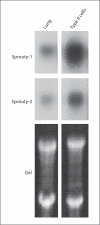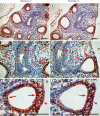Immunolocalization of sprouty-1 and sprouty-2 in developing rat lung
- PMID: 22236546
- PMCID: PMC3270822
- DOI: 10.1159/000332215
Immunolocalization of sprouty-1 and sprouty-2 in developing rat lung
Abstract
Objective: Sprouty, a common antagonist of fibroblast growth factor (FGF) and epidermal growth factor signaling, is a key player regulating tracheal branching and eye development in Drosophila. Four Sprouty homologs have been identified in vertebrates and all share a cysteine-rich region. However, the physiological function(s) of the individual Sprouty homologs is unknown. mRNA of Sprouty homologs is expressed during mouse lung development. In the present study, we investigated the immunolocalization of Sprouty proteins in rat lung at different stages of development.
Methods: Rabbit antibodies were raised against peptides derived from rat Sprouty-1 and Sprouty-2 and were used in Western blot analysis to determine Sprouty distribution in subcellular fractions (pellets and supernatant centrifuged at 5,000 and 20,000 g) and bronchoalveolar lavage fluid (BAL) from adult rat lungs or used in immunohistochemistry.
Results: Western blot analysis revealed a 30-kDa Sprouty-1 band and a 34-kDa Sprouty-2 band in the supernatant and pellet fractions centrifuged at 20,000 g. BAL contained a band of approximately 16 kDa with Sprouty-1 antibody derived from proteolytic fragmentation of Sprouty-1. In embryonic day (E) 14 and E16 lungs, Sprouty-1 and Sprouty-2 were expressed both in epithelial and peripheral mesenchymal cells. In adult rat lung, bronchiolar and alveolar type II epithelial cells showed staining for both Sprouty-1 and Sprouty-2. Sprouty-1 expression was also seen in alveolar type I epithelial cells.
Conclusion: In light of the proximity of the distribution of Sprouty to that of FGF-10 (peripheral mesenchyme) and its receptor FGFR2IIIb (distal tubular epithelium) in lung development, and the finding that FGF-9, which is expressed in mesothelial cells, upregulates FGF-10, it appears that Sprouty expression in epithelial and mesenchymal cells during branching morphogenesis is closely related to signaling by FGF-9 and FGF-10.
Copyright © 2012 S. Karger AG, Basel.
Figures











Similar articles
-
Exogenous fibroblast growth factor-10 induces cystic lung development with altered target gene expression in the presence of heparin in cultures of embryonic rat lung.Pathobiology. 2012;79(3):127-43. doi: 10.1159/000334839. Epub 2012 Jan 18. Pathobiology. 2012. PMID: 22261751 Free PMC article.
-
Expression of Spred and Sprouty in developing rat lung.Gene Expr Patterns. 2002 Dec;2(3-4):347-53. doi: 10.1016/s1567-133x(02)00053-4. Gene Expr Patterns. 2002. Retraction in: Mech Dev. 2002 Dec;119 Suppl 1:S5-10. doi: 10.1016/s0925-4773(03)00085-6. PMID: 12617824 Retracted.
-
Expression of Spred and Sprouty in developing rat lung.Mech Dev. 2002 Dec;119 Suppl 1:S303-9. doi: 10.1016/s0925-4773(03)00132-1. Mech Dev. 2002. PMID: 14516701
-
The molecular basis of lung morphogenesis.Mech Dev. 2000 Mar 15;92(1):55-81. doi: 10.1016/s0925-4773(99)00325-1. Mech Dev. 2000. PMID: 10704888 Review.
-
The molecular genetics of lung morphogenesis and injury repair.Paediatr Respir Rev. 2004;5 Suppl A:S283-7. doi: 10.1016/s1526-0542(04)90052-8. Paediatr Respir Rev. 2004. PMID: 14980285 Review.
Cited by
-
Pleiotropic microRNA-21 in pulmonary remodeling: novel insights for molecular mechanism and present advancements.Allergy Asthma Clin Immunol. 2019 May 20;15:33. doi: 10.1186/s13223-019-0345-2. eCollection 2019. Allergy Asthma Clin Immunol. 2019. PMID: 31139230 Free PMC article. Review.
-
Exogenous fibroblast growth factor-10 induces cystic lung development with altered target gene expression in the presence of heparin in cultures of embryonic rat lung.Pathobiology. 2012;79(3):127-43. doi: 10.1159/000334839. Epub 2012 Jan 18. Pathobiology. 2012. PMID: 22261751 Free PMC article.
-
Morphogenesis of the kidney and lung requires branch-tip directed activity of the Adamts18 metalloprotease.Dev Biol. 2019 Oct 15;454(2):156-169. doi: 10.1016/j.ydbio.2019.06.012. Epub 2019 Jun 23. Dev Biol. 2019. PMID: 31242448 Free PMC article.
References
-
- Casci T, Vinos J, Freeman M. Sprouty, an intracellular inhibitor of ras signaling. Cell. 1999;96:655–665. - PubMed
-
- Hacohen N, Kramer S, Sutherland D, Hiromi Y, Krasnow MA. Sprouty encodes a novel antagonist of FGF signaling that patterns apical branching of the Drosophila airways. Cell. 1998;92:253–263. - PubMed
-
- Kramer S, Okabe M, Hacohen N, Krasnow MA, Hiromi Y. Sprouty: a common antagonist of FGF and EGF signaling pathways in Drosophila. Development. 1999;126:2515–2525. - PubMed
Publication types
MeSH terms
Substances
Grants and funding
LinkOut - more resources
Full Text Sources

